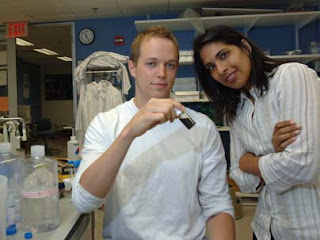With the ability to see the clumped particles, Bhatia’s co-author in the current work, Geoff von Maltzahn, asked the next question: “Can we talk back to them?”
One advantage of a DNA tether is that its melting point is tunable. Longer strands and differently coded strands require different amounts of heat to break. This heat-sensitive tuneability makes it possible for a single particle to simultaneously carry many different types of cargo, each of which can be released at different times or in various combinations by applying different frequencies or durations of electromagnetic pulses.
To test the particles, the researchers implanted mice with a tumor-like gel saturated with nanoparticles. They placed the implanted mouse into the well of a cup-shaped electrical coil and activated the magnetic pulse. The results confirm that without the pulse, the tethers remain unbroken. With the pulse, the tethers break and release the drugs into the surrounding tissue.
The experiment is a proof of principal demonstrating a safe and effective means of tunable remote activation. However, work remains to be done before such therapies become viable in the clinic.
To heat the region, for example, a critical mass of injected particles must clump together inside the tumor. The team is still working to make intravenously injected particles clump effectively enough to achieve this critical mass.
“Our overall goal is to create multifunctional nanoparticles that home to a tumor, accumulate, and provide customizable remotely activated drug delivery right at the site of the disease,” said Bhatia. ###
Co-authors on the paper are Austin M. Derfus, a graduate student at the University of California at San Diego; Todd Harris, an HST graduate student; Erkki Ruoslahti and Tasmia Duza of The Burnham Institute in La Jolla, CA; and Kenneth S. Vecchio of the University of San Diego.
The research was supported by grants from the David and Lucile Packard Foundation, the National Cancer Institute of the National Institutes of Health. Dervis was supported by a G.R.E.A.T fellowship from the University of California Biotechnology Research and Educational Program.
Written by Elizabeth Dougherty, Harvard-MIT Division of Health Sciences and Technology
Contact: Elizabeth Thomson thomson@mit.edu 617-258-5402 Massachusetts Institute of Technology
Technorati Tags: Nano or Nanotechnology and Nanotech and or Massachusetts Institute of Technology and superparamagnetic or Press Conference by the President 12/04/07 VIDEO and Harry Truman, David Ben-Gurion, Abba Eban, Chanukkah menorah and NASA Goddard Space Flight Center's carbon nanotube manufacturing technology wins Nano 50 Award
















No comments:
Post a Comment